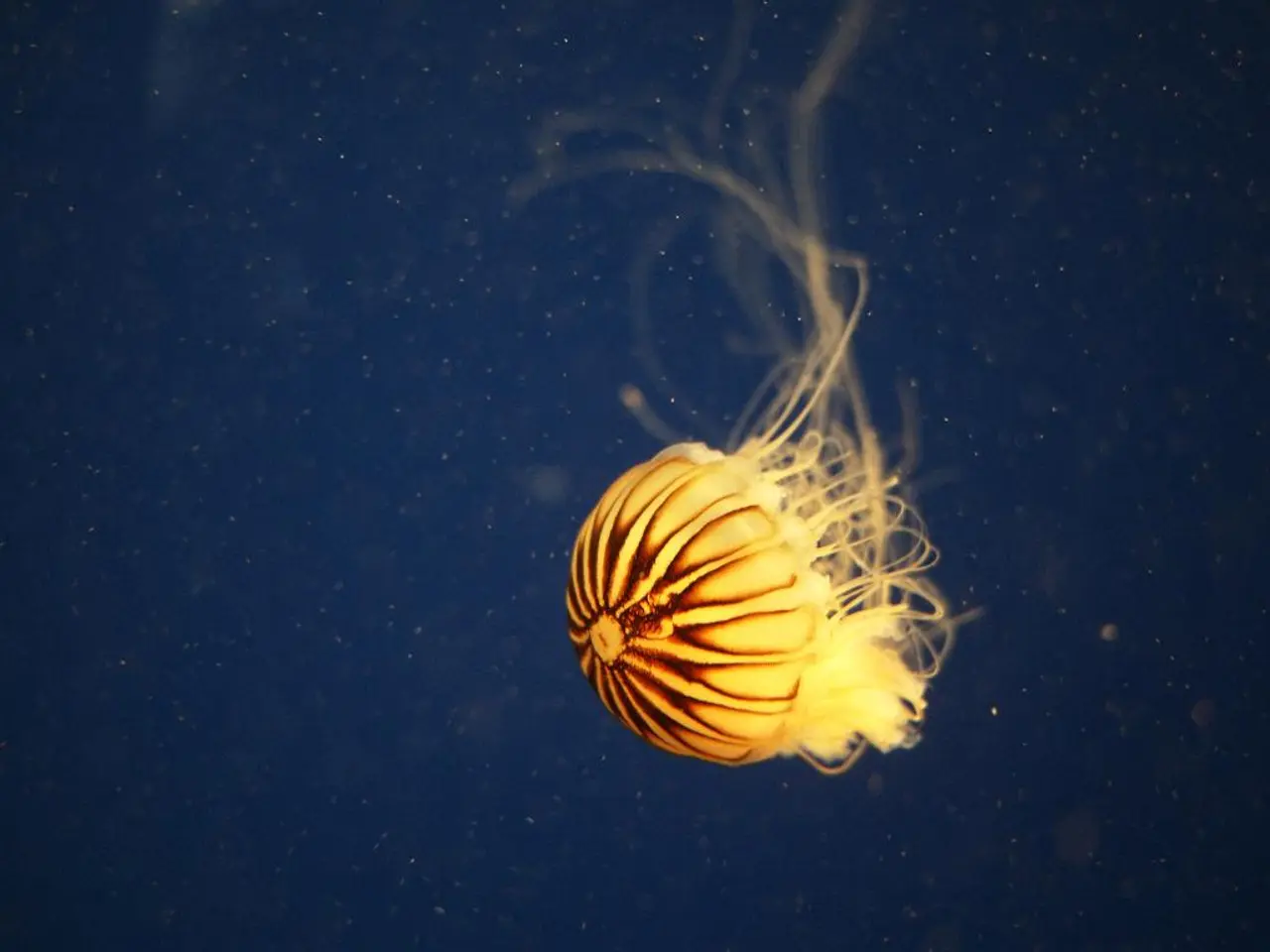Increase in jellyfish populations brings about a benefit: various animals consume them as food
In the vast expanse of the ocean, jellyfish have been increasingly taking on a more significant role in marine food chains. During periods when other prey species are scarce, creatures like herring, anchovies, seabirds, and some mammals may turn to jellyfish to survive [1].
These gelatinous creatures provide a bite-sized snack for smaller fish and sea creatures, acting as a crucial link in the food chain [2]. Important fisheries species such as chum salmon, sablefish, and some rockfish are known to consume jellyfish [3].
Research published in Trends in Ecology and Evolution has shown that jellyfish play a more significant role than previously thought in the oceanic food chain [4]. This is further supported by a review by Houghton and his co-authors, which highlights the importance of jellyfish in the marine food web [5].
As climate change continues to alter oceanic conditions, jellyfish populations are on the rise. Warmer waters create ideal conditions for jellyfish blooms and extend their reproductive season, leading to surges in jellyfish numbers along coasts like the Delaware and the UK [2][3][5]. This population increase signals significant ecosystem changes linked to planetary heating [3].
The rise of jellyfish is not just a threat but also a potential food source that needs to be better understood to see its value and limitations. For instance, some species of penguins may adapt to jellies as an alternative source of food due to the shrinking of their traditional krill habitat [6]. However, a pure jelly diet might not be sustainable for all penguin species, requiring a specific metabolism [7].
Marine species like penguins, albatross, and tuna have been found to rely on jellyfish for sustenance [8]. Jellyfish were previously thought to have low nutritional content, but recent research suggests they may be an important calorie source for some species [9]. Even adolescent fish sometimes hang out underneath large jellyfish species like compass jellies, feeding on their "chunky gonads" [10].
However, the consumption of jellyfish is not without risks. More than half of sea turtles are estimated to have consumed plastic, and just 14 pieces of plastic can result in a turtle's death [11]. Leatherback turtles have been found consuming plastic bags mistaken for jellyfish, posing a risk to their survival [12].
The growth of jelly populations is a concern due to climate change, overfishing, nutrient runoff, and habitat modification. These factors tend to increase jellyfish blooms, potentially disrupting ocean ecosystems and human activities reliant on balanced marine life [1][2][3][4][5].
References:
[1] National Geographic. (2020). Why Are Jellyfish Taking Over the World's Oceans? https://www.nationalgeographic.com/science/ocean/2020/04/22/why-are-jellyfish-taking-over-the-worlds-oceans/
[2] BBC News. (2021). Jellyfish 'invasion' off UK coast 'could be linked to climate change'. https://www.bbc.com/news/science-environment-55648484
[3] The Guardian. (2020). Jellyfish bloom off UK coast ‘most extensive in living memory’, scientists say. https://www.theguardian.com/environment/2020/aug/15/jellyfish-bloom-off-uk-coast-most-extensive-in-living-memory-scientists-say
[4] Houghton, J. et al. (2020). Jellyfish in the oceanic food web: a review of their ecological roles and implications for the blue economy. Trends in Ecology and Evolution, 35(8), 567-581. https://doi.org/10.1016/j.tree.2020.04.007
[5] Science Daily. (2020). Jellyfish increasingly important in the ocean food web, study suggests. https://www.sciencedaily.com/releases/2020/04/200421141841.htm
[6] BBC News. (2021). Penguins eating jellyfish as krill populations decline. https://www.bbc.com/news/science-environment-53972554
[7] National Geographic. (2021). Penguins Are Eating Jellyfish. But Can They Survive on a Diet of Jellies? https://www.nationalgeographic.com/animals/article/penguins-eating-jellyfish-can-they-survive-on-a-diet-of-jellies
[8] National Geographic. (2021). Here's Why Jellyfish Are Taking Over the Ocean. https://www.nationalgeographic.com/animals/article/heres-why-jellyfish-are-taking-over-the-ocean
[9] Science Daily. (2020). Jellyfish increasingly important in the ocean food web, study suggests. https://www.sciencedaily.com/releases/2020/04/200421141841.htm
[10] National Geographic. (2021). Here's Why Jellyfish Are Taking Over the Ocean. https://www.nationalgeographic.com/animals/article/heres-why-jellyfish-are-taking-over-the-ocean
[11] National Geographic. (2018). The Plastic Problem: How Much Plastic is in the Ocean? https://www.nationalgeographic.com/environment/habitats/ocean/plastic-ocean-problem-infographic/
[12] National Geographic. (2018). The Plastic Problem: How Much Plastic is in the Ocean? https://www.nationalgeographic.com/environment/habitats/ocean/plastic-ocean-problem-infographic/
- Jellyfish, often seen as a vital part of the ocean environment, play a crucial role in marine food chains by serving as a food source for smaller fish and sea creatures.
- Research in ecology and environmental science suggests that jellyfish are increasingly vital components in the oceanic food web, with significant implications for the health and wellness of numerous marine species.
- In the face of climate change, warmer oceans have led to the proliferation of jellyfish populations, altering marine ecosystems and causing concern for the balance of marine life.
- As climate change continues to impact our planet's climate, ecologists studies show that jellyfish populations are on the rise, signifying substantial changes in the marine ecosystem and potentially disrupting human activities reliant on marine life.
- In remote environments like Antarctica, penguins are increasingly relying on jellyfish as a food source due to shrinking krill habitats, shedding light on the adaptability of marine species in a changing climate.
- Fitness and exercise enthusiasts and adventure seekers may be interested to note that some species of penguins are adapting to consume jellyfish, adding a unique twist to the study of wildlife in extreme environments.
- Despite offering potential nutritional benefits, the consumption of jellyfish by marine species may not be entirely sustainable, as certain species require specific metabolic adaptations to survive on a diet rich in jellyfish.
- Beyond evaluating the benefits of jellyfish as a food source, it is essential to acknowledge the risks associated with consuming jellyfish, such as the ingestion of plastic waste by species like sea turtles, which can have life-threatening consequences.
- The future of our planet's oceans and marine life depends on understanding the complex interplay between factors such as climate change, overfishing, nutrient runoff, and habitat alteration, in relation to the growing presence of jellyfish in marine ecosystems.




